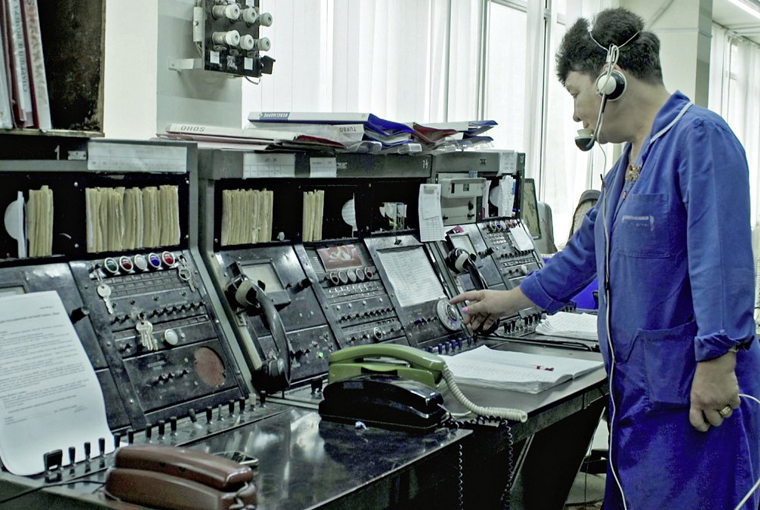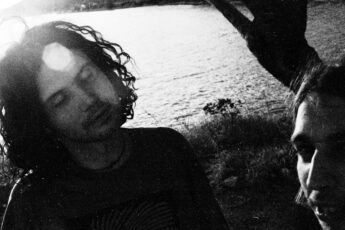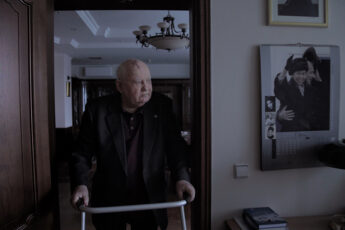Figures of Speech
Pavel Cuzuioc’s Please Hold the Line (2020)
Vol. 114 (April 2021) by Daniil Lebedev
In his documentary Please Hold the Line, Pavel Cuzuioc discovered that there’s something in communication that can reveal itself in the everyday life of cable technicians. This thesis, being quite simple, reveals a reality that buzzes with potential when put into practice. Cable technicians, by entering houses, offices, by climbing roofs, directly interact with communicative centers of people, families, organizations. By connecting buildings with chains of concrete poles that punctuate city communications, they work on the ultimate bond between the home and the street. What they represent, when they enter households to fix a broken telephone wire or to set up an internet connection, is a whole chain of interactions a person has (or doesn’t have) with society. This is where the object of Cuzuioc’s camera reveals itself in the households of Bulgaria, Romania, Ukraine, and Moldova: this object is the reaction people have to the visit of a technician. They start to speak. Now that, firstly, they have material proof of an impossible or impaired communication – a broken TV set, some noise on the telephone line, – and, secondly, they have, in the figure of the technician, a “representative” of communication and also a vacant ear, their imagination unfolds in the most surprising ways: they tell us about everything that they think is broken, that no one ever lets them speak about.
Cuzuioc’s method reminds me of something a writer once said about his way of working: “Like a shopkeeper that opens his shop every morning and waits for his customers, I sit at my desk every morning and wait for words.” Cuzuioc becomes acquainted with technicians in four Eastern European countries and starts to film their everyday: each day they “open their shops” and Cuzuioc turns on his camera. The noisy days when nothing happens stretch like endless wires that go from pole to pole, from house to house, from street to street. These days of communication horde around precious moments of silence, or breaks in communication. A technician comes round when something breaks down, and it is this short timespan when communication is impossible – the duration of a technician’s visit – that speech explodes, rushing through the gap that will be patched as soon as the connection is reestablished and the time of waiting on the line will run out. That is what the title of the film suggests, in my opinion. It is the time spent waiting that marks the beginning of speech; it is in a gap between the message and its response that the speech flows by its own rules. This time of waiting, talking, contemplating (talking with oneself) is fragile and easily broken by the communicative demands of reality: the communication, once interrupted, becomes interruptive. The film succeeds in capturing this process on several occasions: we see a technician fishing on the bank of a quiet river, and a sudden and harsh sound of an incoming call on his mobile phone resonates like some kind of hole in this pastoral painting. Something similar happens with a preacher who uses the time his main telephone is cut off the line to share with us his mystical thoughts – his other phone suddenly starts to ring, he stops mid-sentence, excuses himself and leaves. We see another person who tells a deeply personal story about his deceased son’s drug addiction, and he does that literally standing in the doorway, as if passing from one thing to another, saying what he really has to say in a matter-of-fact manner, in this short moment of hesitation between two rooms that will also be brutally interrupted.
Again, what reveals itself in this gap is not the necessity to communicate, but the necessity to speak. And that’s exactly what, in the eye of the speaker, is lacking in communication: it provides you with means of giving and receiving information, but it doesn’t provide you with a way to be heard. As a result, what we receive from the protagonists are not clear messages, but rather a set of barely articulate, yet very significant expressions. What the brilliant work of Cuzuioc lets us see once more, in an amusing yet also very precise way, is how today speech has become a real kingdom of all that is useless, non-communicative, impractical, how it is ruled not by the supposed diktat of communication but, on the contrary, by some uncontrollable surge that we have to deal with every time we open our mouths, and from which we find refuge in the havens of communication.
The fact that Cuzuioc chooses certain countries for his film is almost irrelevant and has a purely practical cause: he filmed the countries whose languages he happens to speak so as to be able to establish a more personal connection with people. This is one of the most abstract films of the year in that it has the remotest possible bond with everything that is national. I would say that Cuzuioc managed to make a “theoretical documentary,” meaning that he found a way to document the structure of a certain disposition (communication – gap – speech) that would, in one form or another, work with other material as well.




Leave a Comment